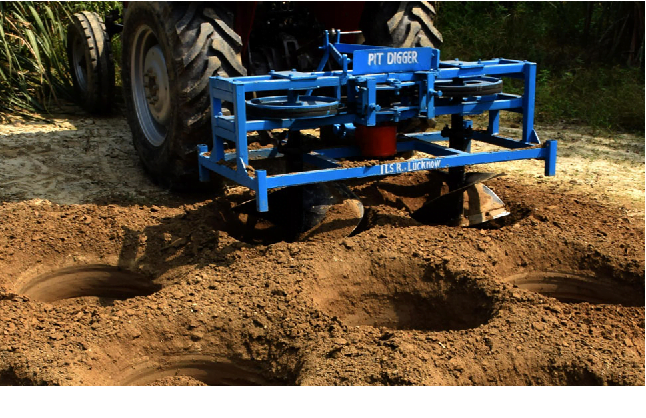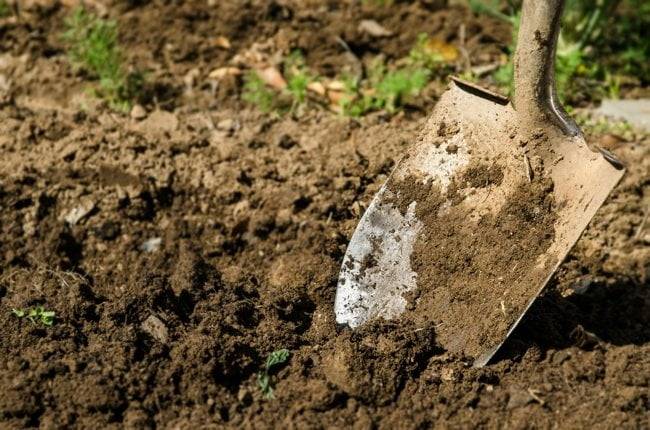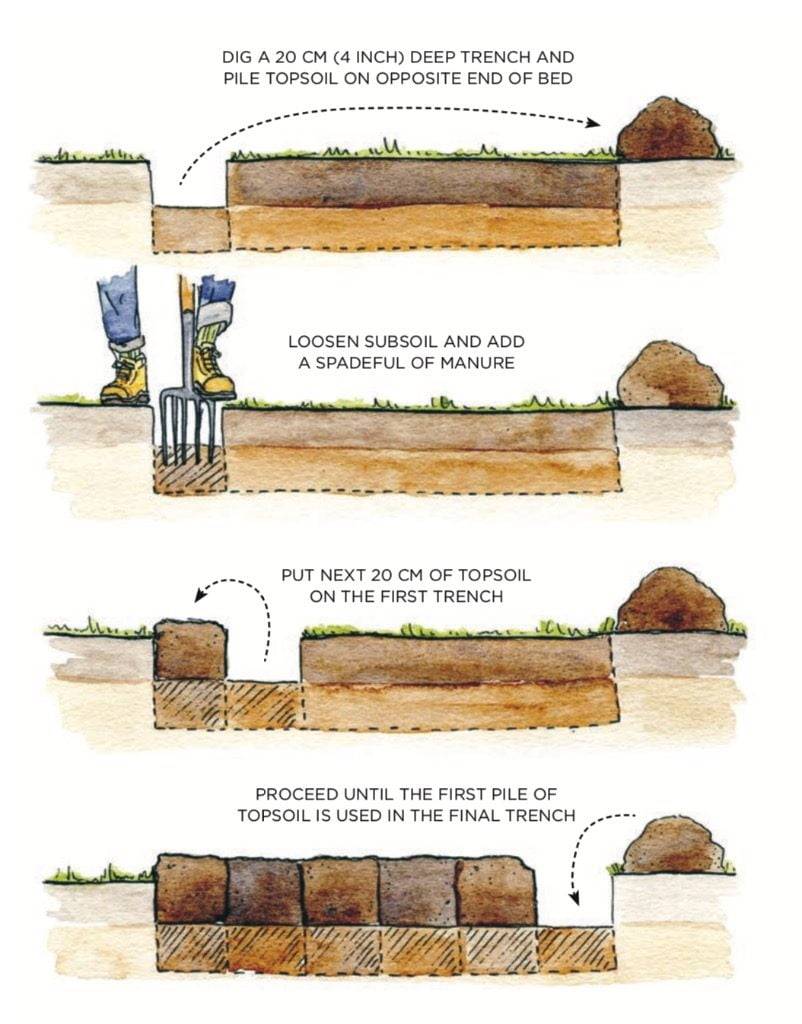In this post, we will talk about Double digger, and we also discuss double digging. Double digger and Double digging are two different topics that we will cover on this page. Here you will get the double digging method also.

What is a Double Digger?
Double Pit Digger is Employed for Ring Pit Method of Cultivation and has Updated the planting of Sugarcane, Banana.
Double Pit Digger will make two pits simultaneously, saving time and labour. This permits cost-effective farming that increases the profit margin for the manufacturer. In addition, our Dual Pit Maker ensures Quality services for an extended period. The digger is a tractor mounted managed by Tractor P.T.O. and Tractor Hydraulic System.
Features
We provide ultra-contemporary Double digger for our clientele. Our Dual Pit Digger conserve your time by making two pits simultaneously. Our Dual Pit Digger is included of the highest quality parts and is ensured for long-term usage. Over time, our Dual Pit Digger can be obtained at market leading prices.
Aids in accommodating higher seed levels in fresh placements by modifying planting procedure, which involves alerting harvest geometry and dirt manipulation, successfully inducing stiff harvest contest at initial phases to eliminate recovery and yield amounts
- Nutrients/ agro compound are implemented in the pits, and their usage is optimized compared to other processes.
- The hole will get sunlight, air and organic matter and so assists in improving soil structure and makeup.
- It eases / guarantees netter water usage efficiency, i.e. less water time and quantity of irrigations required.
- Air, humidity and light can be found in sufficient amount to superior expansion of cane.
- Insects-pests, i.e. eggs, larvae and pupae of borers, white grub and other insects, become exposed and murdered by birds.
- It involves around 25 per cent of their entire region. Operational actions are simple when compared to existing methods.
- Cane is stored from lodging and resulting in yield losses. However, it’s also very Helpful for sugarcane banana and jatropha planting.

Technical Parameters & Description
Double digger is Constituted of the main Framework,
- Main Frame: This Consists of a 50*100 Millimeter Heavy Channel.
- Gear Box: Powerful, Long Lasting constructed from best Substances with top quality standards. The ring Roller Bearings.
- Drill: portion of this drill is 7mm. It is made up of a 4″ dia C course pipe. Cutting blades of exercise is heat cured of total Carbon and are renewable. It is made of a six-bolt flinch.
- Driving P.T.O. Shaft: Produced of 60mm Triangle Pipe in female man Idea. High-quality Carbide substance is Used in making of the yoke and worldwide cross.
Double Digging

Double digging is an alternate way, one that capitalizes on the ground’s natural environmental processes while making it loose enough to plant in right away. The basic premise of double digging is to create an additional deep bed of loose soil — 16 to 18 inches, versus the 6 to 8 inches that most tillers make — without inverting the soil layers.
In the natural process of soil creation, distinct layers, also called “soil horizons,” develop, where the most fertile soil is closest to the top. Mixing the layers with a tiller brings the less-fertile dirt to the surface — that is a disadvantage for plants and a disturbance of their finely tuned relationships of the soil food web. One would eventually lead into the black gold you’d find under the duff in a mature forest or undisturbed grassland, only to have the process set back again by next spring’s tilling.
Double Digging is Suitable for:
Ordinary digging is appropriate enough for many conditions.
It’s unnecessary to dig each calendar year, but it could be required every three to five decades on heavy or poor soils and vegetable gardens. Otherwise, borders only require double digging in their production and on complete replanting.
Pick double digging across other procedures of soil farming in which the soil is compacted. The earth hasn’t been formerly cultivated, where demanding long-term crops like asparagus are proposed or when making double digging raised beds. All barefoot is acceptable for double digging.
Why double dig?
In other words, double digging involves:
- Removing the topsoil layer.
- Exposing the subsoil or hardpan beneath.
- Breaking it up.
- Adding organic matter.
- Replacing the topsoil that was initially released.
Double digging permits roots to achieve more plunging into the ground, where better-draining subsoil makes it less likely they will become water-logged or even oxygen-deprived. In addition, deeper roots imply plants do not need to be watered too frequently. And much more crops can grow in precisely the same area since they do not need to require the topsoil exclusively for nutrients and moisture.
That is the reason behind this easy procedure, but it just does not mean simple. Double digging through rock-hard subsoil is challenging work. Luckily, double digging a mattress is a one-shot deal you will not ever need to replicate. And it is the quickest way to great soil.
When to Double dig
Double digging is done in fall and winter once the ground is moist but not soggy or frozen. The floor then has the time to settle after digging and thick soils, such as the frost, to break the clods before planting in spring. If the soil conditions are good, then double digging may be completed any time of year.
What to takes for digging.
This low-tech procedure requires just a few tools, the most crucial of which is the suitable digging implement. I utilize a short-handled, square-tipped spade instead of a round-tipped spade. The spade permits me to make horizontal, sharp pieces through the dirt, along the short handle compels me to flex my knees while digging, so taking the strain off my lower spine.
You might also require a wheelbarrow for hauling organic thing to function into the mattress. The wheelbarrow may also perform to move topsoil in the initial trench dug into the past; a tarp will work, also.
How to start Digging?
Before you start, determine the beds that you want to be dug. Make them ft. to 4 ft. wide if you would like to reach the centre of the bed from either side. They are sometimes as long as you would like.
Some crops require wide spacing, like tomatoes and eggplant. These don’t have to be put into beds but maybe planted separately with a modified double-digging technique. Double digging an entire mattress for these would mean more extended work. Unless you’re a glutton for hard labour, double digging out a hole is everything you have to do for all these plants.

Procedure for double digging
Healthy soil is essential to a productive garden, so it pays to expend the energy and double dig your way to it. But don’t hurt yourself in the process. Remember to bend your knees and try to keep your back straight. Don’t try to lift too much soil at one time. Take periodic breaks and drink plenty of water.
When you’re ready to go, expose an 18-in. to a 22-in.-deep section of your soil. Typically you’ll find an upper layer of topsoil and subsoil beneath. Sometimes, as in the photo at right, the strata are easily seen. In double digging, you want to work the subsoil, amending it with organic matter.
Also Read: Post Hole Digger Machine, Uses, Prices & more info.
Double Dig Method
1
To double digging garden beds, start at one end and move backwards. Once the soil is loosened, turned, and aerated, you don’t want to step on it again, as compaction defeats one of the double-digging purposes. Instead, dig a trench across the width of the bed, removing the topsoil and piling it at the top of the bed on a tarp or in a wheelbarrow. The track should be 6 in. or 7 in. wide, the width of your spade, and as deep as your spade, 9 in. to 11 in.
2
Fresh manure or some other harsh, non-woody plant matter such as leaves, grass, or blossom stalks can be utilized. I enjoy hollow cornstalks and citrus stalks since the atmosphere trapped inside them enable germs in the soil to thrive and also hastens the breakdown of organic matter and the creation of humus. Do not use diseased plants since they might infect the dirt and continue the illness to potential crops. And save your fine compost from blending in the topsoil as soon as you’ve finished digging out the mattress. If this is the first backyard and you do not have a supply of organic substances to grow your soil, commercially bagged mulch or compost will do.
3
When it’s extremely rough and rugged, take 2-in. to 3-in. Sections at one time. Remove large stones as you move. You wish to split the hardpan into little balls interspersed with the natural matter, providing channels for water to drain and roots to develop into. If you find a dirt fork works better than a shovel with this floor coating, by all means, use it.
4
There, you have double dug the initial trench. Next, begin another trench parallel to and just behind the initial, one spade-width broad and one spade-depth deep. Finally, twist the topsoil in the next track in addition to the initial trench’s mix of organic substance and subsoil.
6
Keep double digging trenches down the amount of your mattress. When you reach the end of the bed, then you may be one layer brief of topsoil. Proceed to the peak of the mattress in which you set the topsoil out of your very first trench, and bring that layer of topsoil down to disperse on the previous track.
7
Rake smooth the bed’s cover, add a few fine compost or other soil modification, and your double-dug mattress is finished. You will see it is increased 6 in. Or over the surrounding region. That is due not just to the accession of this natural substance but also to the de-compaction of existing dirt. And this is the way soil ought to be loose, accentuated, well ventilated, and as pleasing to the eye since it’s going to be to your crops.
Advantages of Double Digging
The advantages of this Strategy are:
If the planting beds aren’t then walked, that exceptionally loose soil remains well aerated through the growing season. Plant roots, soil water and organisms also have a simpler time moving through the dirt for greater nutrient availability.
Different slow-release soil amendments may be introduced while the mattress is dug, instead of only spread on shirt or side-dressed along with the roots. This comprehensive mixing consequently brings these differently slow-to-sink-in substances directly into the root canal.
But in this instance, the thickness of the fine soil goes down under level, instead of only resting at the top of floor level.
This Strategy creates the finest seedbed I have ever had the joy of working with, bar none. I have never approached this fine and uniform seedbed consistency using any other guide or mechanical farming approach. It is a pure pleasure to use.
Once beds are double-dug, they become easier to operate over time. Reportedly, soils that have been double-dug for decades reach a point where they do not have to be dug anymore. But, unfortunately, we are not there yet.
Disadvantages of Double Digging
This Strategy can be genuinely challenging to construct. If you have 100sqft of planting bed to prepare, that is a half-day of solid work, yet it’s do-capable. On the off chance that you have 10,000 sqft of planting region to prepare, you either need to pay off particular companions, employ some assistance, or begin diving your beds in pre-winter (which is not an ill-conceived notion all by itself). However, you’d always be unable to prepare that much ground without anyone else in springtime with digging tool and fork, and still, complete whatever else.
There are soil researchers, natural producers and conventional landscapers who might all fight the blending of different soil layers. This Strategy doesn’t appear to make the feared rototiller hardpan underneath the burrowed region, however, blending that dirt laters is a no-no as per these people. I sincerely don’t have the foggiest idea of how enormous a difficulty that is. It might rely upon the dirt you’re working with. We have never seen issues with blending those layers here; however, that could be our site qualities.
Suppose you have shallow soils, i.e. 24″ profound or more miniature among surface and bedrock, water table, mud, or other unfortunate layers. In that case, you might be better off developing the dirt instead of burrow right down to that hindrance. Huge stones and rocks at those lower profundities can likewise make genuine cerebral pains, either moving or working around. Shallow culturing could keep away from those snags.
